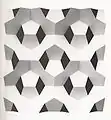Conway criterion
In the mathematical theory of tessellations, the Conway criterion, named for the English mathematician John Horton Conway, is a fast way to identify many prototiles that tile the plane; it consists of the following requirements:[1] The tile must be a closed topological disk with six consecutive points A, B, C, D, E, and F on the boundary such that:
- the boundary part from A to B is congruent by translation to the boundary part from E to D
- each of the boundary parts BC, CD, EF, and FA is centrosymmetric—that is, each one is congruent to itself when rotated by 180-degrees around its midpoint
- some of the six points may coincide but at least three of them must be distinct.[2]


Any prototile satisfying Conway's criterion admits a periodic tiling of the plane—and does so using only translation and 180-degree rotations. The Conway criterion is a sufficient condition to prove that a prototile tiles the plane but not a necessary one; there are tiles that fail the criterion and still tile the plane.[3]
Examples


In its simplest form the criterion states that any hexagon whose opposite sides are parallel and congruent (that is, any hexagonal parallelogon) will tessellate the plane by translation.[4] But when some of the points coincide, the criterion can apply to other polygons and even to shapes with curved perimeters.[5]
The Conway criterion is sufficient, but not necessary, for a shape to tile the plane. For each polyomino up to order 8 that can tile the plane at all, either the polyomino satisfies the Conway criterion or else two copies of the polyomino can be combined to form a polyform patch that satisfies the criterion.[3] The same is true of every tiling nonomino, except for the two tiling nonominoes on the right.[3]
References
- Will It Tile? Try the Conway Criterion! by Doris Schattschneider Mathematics Magazine Vol. 53, No. 4 (Sep., 1980), pp. 224-233
- Periodic Tiling: Polygons in General
- Rhoads, Glenn C. (2005). "Planar tilings by polyominoes, polyhexes, and polyiamonds". Journal of Computational and Applied Mathematics. 174 (2): 329–353. doi:10.1016/j.cam.2004.05.002.
- Polyominoes: A Guide to Puzzles and Problems in Tiling, by George Martin, Mathematical Association of America, Washington, DC, 1991, p. 152, ISBN 0883855011
- The five types of Conway Criterion polygon tile Archived 2012-07-06 at the Wayback Machine, PDF file
External links
- History and introduction to polygon models, polyominoes and polyhedra, by Anthony J Guttmann
- G C Rhoads (2005) Planar tilings by polyominoes, polyhexes, and polyiamonds, Journal of Computational and Applied Mathematics, V 174 p 329-353

